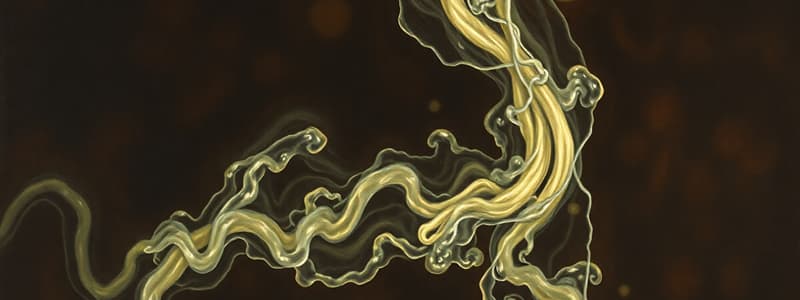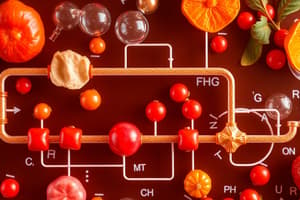Podcast
Questions and Answers
Which enzyme is responsible for hydrolyzing sucrose?
Which enzyme is responsible for hydrolyzing sucrose?
- Lactase
- Sucrase (correct)
- Glucoamylase
- Isomaltase
What role does the ATP-driven Na+ pump play in glucose absorption?
What role does the ATP-driven Na+ pump play in glucose absorption?
- It inhibits the absorption of other sugars.
- It helps maintain low cellular sodium levels. (correct)
- It increases cellular sodium concentration.
- It directly transports glucose into the blood.
How is fructose absorbed in the epithelial cells?
How is fructose absorbed in the epithelial cells?
- Via the channel protein GLUT5 and down its concentration gradient. (correct)
- Through active transport via Na+ channels.
- By direct diffusion without any proteins.
- Coupled with glucose transport mechanisms only.
What is a significant consequence of a lack of oligosaccharides in the diet?
What is a significant consequence of a lack of oligosaccharides in the diet?
What is the general effect of cellulose and hemicellulose on digestion?
What is the general effect of cellulose and hemicellulose on digestion?
What is the primary function of carbohydrates in the body?
What is the primary function of carbohydrates in the body?
Which of the following is NOT a hexose important in human biochemistry?
Which of the following is NOT a hexose important in human biochemistry?
What type of bond is formed when two monosaccharides link together?
What type of bond is formed when two monosaccharides link together?
Which carbohydrate is primarily stored in plants?
Which carbohydrate is primarily stored in plants?
What reaction occurs at the anomeric carbon during the formation of glycosidic bonds?
What reaction occurs at the anomeric carbon during the formation of glycosidic bonds?
What is a primary symptom of von Gierke's disease?
What is a primary symptom of von Gierke's disease?
What treatment is recommended for managing von Gierke's disease?
What treatment is recommended for managing von Gierke's disease?
In McArdle's disease, what is a notable change after exercise?
In McArdle's disease, what is a notable change after exercise?
Which process is impaired in patients with von Gierke's disease?
Which process is impaired in patients with von Gierke's disease?
Which of the following statements is true regarding McArdle's disease?
Which of the following statements is true regarding McArdle's disease?
Which disaccharide is formed from a glycosidic bond between galactose and glucose?
Which disaccharide is formed from a glycosidic bond between galactose and glucose?
What distinguishes sucrose from maltose and lactose regarding oxidation?
What distinguishes sucrose from maltose and lactose regarding oxidation?
What is the metabolic consequence of the deficiency in glucose 6-phosphatase in von Gierke's disease?
What is the metabolic consequence of the deficiency in glucose 6-phosphatase in von Gierke's disease?
At what age do symptoms of McArdle's disease typically become apparent?
At what age do symptoms of McArdle's disease typically become apparent?
What is the primary structural difference between amylose and amylopectin?
What is the primary structural difference between amylose and amylopectin?
Which statement accurately describes glycogen's structure compared to starch?
Which statement accurately describes glycogen's structure compared to starch?
What is the effect of exercise on blood glucose levels in McArdle's disease?
What is the effect of exercise on blood glucose levels in McArdle's disease?
What role does carbon #1 on the glucose residue play in its structure?
What role does carbon #1 on the glucose residue play in its structure?
Which of the following is true regarding maltose as a sugar?
Which of the following is true regarding maltose as a sugar?
What is a characteristic of polysaccharides?
What is a characteristic of polysaccharides?
Where is the majority of glycogen stored in the body?
Where is the majority of glycogen stored in the body?
What are the non-reducing ends of amylopectin and glycogen responsible for?
What are the non-reducing ends of amylopectin and glycogen responsible for?
What is the primary function of glycoproteins?
What is the primary function of glycoproteins?
How are proteoglycans formed?
How are proteoglycans formed?
Which statement accurately describes mucopolysaccharidoses?
Which statement accurately describes mucopolysaccharidoses?
What is a common consequence of Hurler syndrome?
What is a common consequence of Hurler syndrome?
Where does the primary digestion of carbohydrates occur in the digestive system?
Where does the primary digestion of carbohydrates occur in the digestive system?
Which carbohydrates are considered unable to be digested by humans?
Which carbohydrates are considered unable to be digested by humans?
What role do glycosaminoglycans typically play in the body?
What role do glycosaminoglycans typically play in the body?
What carbohydrate is primarily sourced from meat, but degrades after the animal's death?
What carbohydrate is primarily sourced from meat, but degrades after the animal's death?
What is the mass percentage range of carbohydrates typically found in glycoproteins?
What is the mass percentage range of carbohydrates typically found in glycoproteins?
Which factor does NOT contribute to disaccharidase deficiencies?
Which factor does NOT contribute to disaccharidase deficiencies?
What is the most common symptom of lactose intolerance?
What is the most common symptom of lactose intolerance?
What primarily happens to glucose once absorbed by the intestine?
What primarily happens to glucose once absorbed by the intestine?
Which enzyme is active in the liver for phosphorylating glucose?
Which enzyme is active in the liver for phosphorylating glucose?
Which of the following tissues does NOT have glucose 6-phosphatase?
Which of the following tissues does NOT have glucose 6-phosphatase?
How does hexokinase’s low Km value affect glucose uptake?
How does hexokinase’s low Km value affect glucose uptake?
What initiates the synthesis of glycogen from glucose monomers?
What initiates the synthesis of glycogen from glucose monomers?
Which product is released during the degradation of glycogen?
Which product is released during the degradation of glycogen?
Which enzyme removes glucose from the non-reducing ends during glycogen mobilization?
Which enzyme removes glucose from the non-reducing ends during glycogen mobilization?
What happens to glucose 6-phosphate in the liver when blood glucose levels fall?
What happens to glucose 6-phosphate in the liver when blood glucose levels fall?
Which pathway does NOT involve glucose 6-phosphate?
Which pathway does NOT involve glucose 6-phosphate?
Which condition leads to the highest activity of glucokinase?
Which condition leads to the highest activity of glucokinase?
What is the relationship between glucose 6-phosphate and glycogen synthesis?
What is the relationship between glucose 6-phosphate and glycogen synthesis?
Flashcards
Monosaccharides
Monosaccharides
Simple sugars with 3 important hexoses (6-carbon sugars) including glucose, galactose, and fructose.
Disaccharides
Disaccharides
Sugars formed when monosaccharides bond via glycosidic bonds.
Carbohydrate function
Carbohydrate function
Carbohydrates provide energy, store energy (starch/glycogen), have structural roles (plant cell walls), and contribute to cell communication.
Glycosidic bonds
Glycosidic bonds
Signup and view all the flashcards
Anomeric carbon
Anomeric carbon
Signup and view all the flashcards
Anomers
Anomers
Signup and view all the flashcards
Reducing Sugars
Reducing Sugars
Signup and view all the flashcards
Maltose
Maltose
Signup and view all the flashcards
Lactose
Lactose
Signup and view all the flashcards
Sucrose
Sucrose
Signup and view all the flashcards
Homopolysaccharides
Homopolysaccharides
Signup and view all the flashcards
Amylose
Amylose
Signup and view all the flashcards
Glycogen
Glycogen
Signup and view all the flashcards
Isomaltase's role
Isomaltase's role
Signup and view all the flashcards
Glucoamylase's function
Glucoamylase's function
Signup and view all the flashcards
How is glucose absorbed?
How is glucose absorbed?
Signup and view all the flashcards
Fructose absorption
Fructose absorption
Signup and view all the flashcards
Cellulose & Hemicellulose's benefits
Cellulose & Hemicellulose's benefits
Signup and view all the flashcards
Amylopectin/Glycogen Compactness
Amylopectin/Glycogen Compactness
Signup and view all the flashcards
Glycoproteins
Glycoproteins
Signup and view all the flashcards
Glycosaminoglycans (GAGs)
Glycosaminoglycans (GAGs)
Signup and view all the flashcards
Proteoglycans
Proteoglycans
Signup and view all the flashcards
Difference between Glycoproteins and Proteoglycans
Difference between Glycoproteins and Proteoglycans
Signup and view all the flashcards
Mucopolysaccharidoses
Mucopolysaccharidoses
Signup and view all the flashcards
Hurler Syndrome
Hurler Syndrome
Signup and view all the flashcards
Digestion of Starch (Mouth)
Digestion of Starch (Mouth)
Signup and view all the flashcards
Digestion of starch (Duodenum)
Digestion of starch (Duodenum)
Signup and view all the flashcards
Digestion of carbohydrates (Jejunum)
Digestion of carbohydrates (Jejunum)
Signup and view all the flashcards
Disaccharidase Deficiency
Disaccharidase Deficiency
Signup and view all the flashcards
Lactase Intolerance
Lactase Intolerance
Signup and view all the flashcards
Why does lactase deficiency cause symptoms?
Why does lactase deficiency cause symptoms?
Signup and view all the flashcards
What happens to glucose after absorption?
What happens to glucose after absorption?
Signup and view all the flashcards
Why can't glucose 6-phosphate leave the cell?
Why can't glucose 6-phosphate leave the cell?
Signup and view all the flashcards
Glucokinase vs Hexokinase
Glucokinase vs Hexokinase
Signup and view all the flashcards
Liver's role in glucose regulation
Liver's role in glucose regulation
Signup and view all the flashcards
Other tissues' role in glucose regulation
Other tissues' role in glucose regulation
Signup and view all the flashcards
Fates of glucose 6-phosphate
Fates of glucose 6-phosphate
Signup and view all the flashcards
Glycogen's role
Glycogen's role
Signup and view all the flashcards
How is glycogen synthesized?
How is glycogen synthesized?
Signup and view all the flashcards
Glycogen branching
Glycogen branching
Signup and view all the flashcards
What is glycogen's structure?
What is glycogen's structure?
Signup and view all the flashcards
How is glycogen degraded?
How is glycogen degraded?
Signup and view all the flashcards
What happens to glycogen when it's degraded?
What happens to glycogen when it's degraded?
Signup and view all the flashcards
Von Gierke's Disease
Von Gierke's Disease
Signup and view all the flashcards
Von Gierke's Disease Symptoms
Von Gierke's Disease Symptoms
Signup and view all the flashcards
Von Gierke's Disease Treatment
Von Gierke's Disease Treatment
Signup and view all the flashcards
McArdle's Disease
McArdle's Disease
Signup and view all the flashcards
McArdle's Disease Symptoms
McArdle's Disease Symptoms
Signup and view all the flashcards
McArdle's Disease Treatment
McArdle's Disease Treatment
Signup and view all the flashcards
Cori Cycle
Cori Cycle
Signup and view all the flashcards
Glycogen Phosphorylase (in McArdle’s Disease)
Glycogen Phosphorylase (in McArdle’s Disease)
Signup and view all the flashcards
Study Notes
Carbohydrate Metabolism (Lecture 1)
- The lecture is about carbohydrate structure, function, digestion, and storage.
- The lecturer is John Barrow, [email protected].
Aims of Carbohydrate Lectures 1 & 2
- Review carbohydrate structures and functions
- Review carbohydrate digestion and absorption
- Review the initial fate of glucose when it enters the cells of the body
- Review glycolysis and substrate-level phosphorylation
- Review gluconeogenesis and anabolic pathways
Carbohydrates
- Highly oxidizable
- Sugar and starch molecules have "high energy" H-atom associated electrons.
- Carbohydrates are a major energy source.
- Carbohydrate catabolism is the major metabolic process for many organisms
- Function to store potential energy (starch in plants, glycogen in animals)
- Have structural and protective functions (in plant cell walls, extra cellular matrices of animal cells).
- Contribute to cell-cell communication (e.g., ABO blood groups)
Monosaccharides
- Three important hexoses (6-carbon sugars) in human biochemistry: glucose, galactose, fructose.
Disaccharides
- Formed from monomers linked by glycosidic bonds.
- Different anomers are mirror images of each other (left- and right-handed forms).
- Carbon #1 on the glucose residue is the anomeric carbon).
- It stabilizes the structure of glucose.
- It is the only residue that can be oxidized.
- Important disaccharides in human biochemistry are maltose, lactose, and sucrose.
Maltose
- Breakdown product of starch, found in beer.
- Anomeric C-1 is available for oxidation, so maltose is a reducing sugar.
Lactose
- Main sugar in milk.
- Formed from a glycosidic bond between galactose and glucose.
- Anomeric carbon on the glucose is available for oxidation (reducing sugar).
Sucrose
- Common table sugar
- Only made by plants
- Approximately 25% of dietary carbohydrate, sweetener in processed foods, non-reducing sugar.
Polysaccharides
- Polymers of medium to high molecular weight
- Distinguished by the identity of their recurring monosaccharide units, their length, bond types, and branching patterns.
- Homopolysaccharides: single monomeric species
- Heteropolysaccharides: two or more monomeric species.
Starch
- Contains two types of glucose polymer: amylose (20-25% of starch), amylopectin (75-80% of starch).
- Has many non-reducing ends.
- Amylose and amylopectin form alpha-helices.
Glycogen
- Animal cells use a similar strategy as plants to store glucose (polymer of glucose).
- Glucose (α1→4) linked sub-units with (1→6) branches every 8 to 12 residues: makes glycogen extensively branched, compared to starch.
- Primarily found in liver and skeletal muscle.
Why Store Glucose in Polymers?
- Compactness (amylopectin and glycogen have many non-reducing ends).
- Readily synthesized and degraded, speeding up formation and breakdown.
- Not osmotically active in solution.
Glycoproteins
- Proteins that have carbohydrates covalently attached
- Most extracellular eukaryotic proteins have associated carbohydrate molecules
- Carbohydrate content by mass varies between 1-80%
- Increases solubility, influences protein folding, protects from degradation, acts as communicator.
Glycosaminoglycans (GAGs)
- Unbranched polymers made from repeating units of hexuronic acid and amino-sugar.
- Alternate through the chains.
- Include Chondroitin 6-sulfate, Keratan sulfate, Heparin, and Hyaluronate, Dermatan sulfate.
Proteoglycans
- Formed from GAGs covalently attached to proteins.
- Macromolecules found on cell surfaces or in extracellular matrix.
- Part of many connective tissues in the body.
Glycoproteins
- Similar in structure and function to proteoglycans; found on plasma membranes, extracellular matrix, and within cells of secretory system.
- Some cytoplasmic and nuclear proteins are also glycoproteins.
Cellulose and Hemicellulose
- Cannot be digested by gut.
- Increase faecal bulk and decrease transit time.
- Broken down by gut bacteria (Yielding CH₄ and H₂).
Disaccharidase Deficiencies
- Genetic or resulting from severe intestinal infection, gut lining inflammation/damage/removal, or drugs).
- Characterized by abdominal distension and cramps.
- Diagnosis requires enzyme tests of intestinal secretions (checking for lactase, maltase, or sucrase activity).
Lactose Intolerance
- Most common disaccharide deficiency (loss of lactase activity).
- Western whites generally retain lactase activity into adulthood.
- Ingestion of milk may cause gas buildup, irritation, osmotic diarrhea if lactase is absent or low.
- Symptomatic relief can be achieved by avoidance of milk products or supplementation with lactase.
Fate of absorbed Glucose
- Glucose diffuses through intestinal epithelium cells, into portal blood and to liver.
- immediately phosphorylated into glucose-6-phosphate, trapped by absence of GLUT transporters.
- Liver and other tissues enzymes trap Glucose-6-phosphate: Glucokinase and Hexokinase.
Glucokinase/Hexokinase
- Hexokinase’s low Km means it can grab Glc even at low concentrations
- Glucokinase’s high Vmax means it can phosphorylate Glc quickly, trapping it in the liver
- Blood glucose levels impact the efficiency of each enzyme.
Fates of glucose-6-phosphate (G-6-P)
- The liver metabolizes glucose-6-phosphate
- Other tissues use it for the pentose phosphate pathway or glycolysis.
Glycogen
- 90% in the liver and skeletal muscle.
- In the liver, glycogen is used to maintain blood glucose levels (e.g., after blood glucose falls, glycogen is converted to glucose-6-phosphate, then to glucose).
- In skeletal muscle, glycogen is used as a source of energy (glycogen → glucose-6-phosphate → pyruvate → lactate).
Synthesis of Glycogen (Step 1)
- Glycogen does not form directly from glucose monomers.
- Glycogenin initiates the process by covalently binding UDP-glucose for branching.
- Glycogen synthase takes over subsequently forming chains of approximately 8 glucose residues.
Synthesis of Glycogen (Step 2)
- Glycogen synthase chains are re-attached by glycogen branching enzyme.
- Attached via (α1→6) bonds creating a branch points.
Degradation (Mobilization) of Glycogen
- Glc monomers are one-by-one removed from glycogen nonreducing ends.
- Glycogen-phosphorylase breaks (α1→4) bonds.
- Debranching enzyme removes a set of three glucose residues.
- The set is re-attached to the nonreducing end of another chain.
What happens to all this glycogen?
- Liver: Glucose-6-phosphate (G-6-P), then Glucose.
- Skeletal muscles: Glucose-6-phosphate → pyruvate → lactate
Von Gierke's Disease
- Liver (and kidney, intestine) glucose 6-phosphatase deficiency.
- Symptoms include high liver glycogen, low blood glucose, and high lactate.
- Treatment includes regular carbohydrate feeding (often, every 3 to 4 hours)
McArdle's Disease
- Skeletal muscle glycogen phosphorylase deficiency
- Symptoms include high muscle glycogen, weakness and cramps after exercise, and no increased blood glucose after exercise.
- Treatment involves avoiding strenuous activity, and using brief periods of anaerobic activity to be followed by aerobic exercise.
Studying That Suits You
Use AI to generate personalized quizzes and flashcards to suit your learning preferences.



